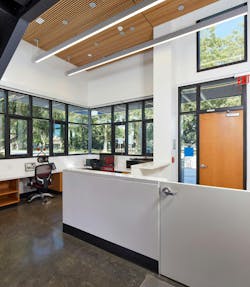A recent news article about the Rancho Mission Viejo, CA, Fire Station 67 caught my attention. Not only because the station was a modular facility built around a center courtyard, but because of the open airiness of the station and views of the mountains. The open apparatus bays on both ends protect the vehicles but also provide a pavilion for exercise equipment (pickleball!), gatherings and events.
The landscape and use of natural surroundings are one element of immersive design, which incorporates design elements that encourage physical, emotional and mental healing through increased attention to circadian rhythms, daylight, color and views of natural settings.
Paul Erickson, FAIA, FGM Architects, presented at the 2019 Station Design Conference, “Immersive Design for Reduction of PTSD and Suicide.” Erickson introduced the Hot Zone Design concept in 2014 and has continued his research on firefighter health, particularly on mental health. The increased rate of PTSD and suicides among firefighters, EMTs and law enforcement has brought urgent attention to providing holistically healthy environments for public safety personnel.
In an interview with Erickson in 2020, he shared, “Fire departments and architects now are called to place the crew’s health and well-being first in every renovation or new fire station design that they undertake.”
Another concept Erickson shared was called biophilic design. “It emphasizes the connection between humans and the natural world by intentionally incorporating trees and natural plant material, views to the outdoors and natural building materials into the manmade environment,” he said. “While embracing biophilic design, modern healthcare architecture also introduces representations of nature into healing environments by using flowing or complex organic forms and patterns in room finishes (think floor tiles, wall coverings, fabrics, upholstery, drapery, etc.) and artwork. The result is a rich, visually interesting environment that has color, depth, daylight and layers of space.”
Back to nature
In recent entries in the Station Design Awards program, architects and fire departments have designed their new stations to take advantage of the site selections’ natural environment.
In California, Palo Alto Fire Station No. 3 is located within the city’s Rinconada Park. The station is clad in natural terra cotta and gray zinc panels and the materials blend well in the city park setting of mature redwoods. With large windows throughout and strategically placed for privacy, the firefighters of Station No. 3 refer to the station as the “Tree House.”
Some small sites for a new fire station are restricted from expansion and prohibited from the removal of trees due to the historic surroundings.
The new Raleigh, NC, Fire Station No. 6 created many challenges to replace the existing station built in 1949. The site was relatively small and created many challenges, including the very old specimen hardwood trees that were preserved and shared a property line with a prominent, historic residence.
But not all new or existing fire stations are in lush, green areas or mountains to offer views and nature’s healing benefits. Areas where the soil is not conducive to adding green landscape, offer various other options. The Goodyear Fire Station No. 181’s side area is stone-covered with low greens planted. The desert-like environment also offers fire stations their own style of calm.
Fire stations located in urban and suburban areas have other options if the space doesn’t allow views of the outdoors.
In a memorable conversation with Fire Chief Greg Flynn, West Bloomfield, MI, Fire Department, he said the big fire-based, action pictures hung in the fire station were replaced with photos taken on vacation by the firefighters. No people in the pictures, just scenes that brought back good memories, a favorite fishing spot, a park, or other natural setting.
Design a fire station for a healthy environment inside and outside.
About the Author
Janet A. Wilmoth
Special Projects Director
Janet Wilmoth grew up in a family of firefighters in a suburb of Chicago. Wilmoth, who is owner of Wilmoth Associates, worked with Fire Chief magazine for 27 years until it closed in 2013. She currently is the project director for Firehouse, overseeing the Station Design Conference.


